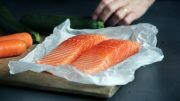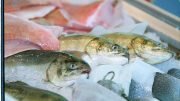The seafood industry is one of Norway’s largest export industries – after oil and gas. So when a change in leadership at the Norwegian Seafood Council takes place after six years, people notice.
The Norwegian Seafood Council is a public company owned by the Ministry of Trade, Industry, and Fisheries. It works together with the Norwegian fisheries and aquaculture industry to develop markets for Norwegian seafood.
After six years as CEO of the Norwegian Seafood Council, Renate Larsen decided to resign in February. The decision was hers alone, according to an article on the website of the Norwegian Seafood Council.
“There’s no drama behind my decision. I have had six fantastic and exciting years with the Norwegian Seafood Council. I have had the privilege to work with a competent and adaptable organization that I will miss. There is a time for everything, and it feels that the time is right for me to do something else”, Larsen said in February of this year.
On April 29, it was announced that Børge Grønbech would step in as the acting director of the Norwegian Seafood Council from May 1. Grønbech has been the director of global operations since May 2018 and has been employed by the Seafood Council since 1998.
Norway Today reached out to the Norwegian Seafood Council to get more information on the company’s plans for the future.
–
NT: Two weeks ago, it was announced that Børge Grønbech would take over from Renate Larsen in May – on a temporary basis. What are the first steps Mr. Grønbech plans to take on this position?
NSC: Mr. Grønbech has announced his intentions to continue down the path that the company has been on for the last period. Already being a part of the management team, he has been heavily involved with the strategy work and the direction that the company is heading.
Mr. Grønbech has highlighted the importance of keeping up the tempo and level of energy from the Seafood Council’s end to ensure that we continue to deliver on our most important mission; increasing the value of Norwegian seafood in strong collaboration with the Norwegian seafood industry.
In addition, he has signaled his intentions to throw his hat in the ring for the permanent position as CEO of the Norwegian Seafood Council.
NT: When will the position for the new permanent leader at the NSC be posted? How does the recruitment process look?
NSC: The ads were posted last week, and a third party is conducting an active candidate search. The deadline for applicants is ultimo May, and the board will look to appoint a new CEO at the end of June, at the final board meeting before the summer holidays here in Norway.
NSC: Record value in Norwegian seafood exports was reported in the first quarter of the year. What do you expect for the second quarter and 2022 in general?
NSC: With the numbers for April being announced last week, the trend from Q1 continues. Higher prices for our key species such as salmon, cod, trout, and haddock were the biggest contributors to value growth this month. It’s reasonable to believe that Q2 as a whole would surpass last year’s record-high levels.
NT: What is driving the current global demand for Norwegian seafood?
NSC: Healthy, tasteful seafood from Norway, which is of the highest quality, will always be in demand. In general, a lower supply of the most popular species, both from Norway and other countries, results in high prices, as demand is ever-growing.
Consumers are increasingly aware of the benefits of seafood and demand a sustainable source of protein. Norwegian seafood is the answer to many of these demands and wishes. In addition, whilst global food prices are rising sharply at the moment, people have learned to cook more seafood at home during the pandemic – and are prioritizing their seafood meals to a larger extent.
NT: How are the sanctions imposed on Russia and the war in Ukraine affecting Norwegian seafood exports?
NSC: It is still demanding to maintain a global retail trade in the wake of the ongoing war and the subsequent sanctions. More expensive input factors, rising energy and fuel prices, and more demanding logistics are some of the factors that contribute to this.
Furthermore, it will be challenging to build markets with such fluctuating prices, even if Norwegian seafood is stable both in terms of supply and demand.
Robin-Ivan Capar is a contributor and editor at Norway Today.
Source: #Norway Today / #NorwayTodayFinance
Do you have a news tip for Norway Today? We want to hear it. Get in touch at [email protected]





Be the first to comment on "How will a change in leadership affect the key public company in Norway’s booming seafood industry?"